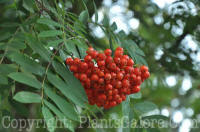|
 Perhaps the first point to make about
Mountain Ash tree is that it is NOT a true ash at all.
It is from the genus,
Sorbus, while the true ash is of the genus,
Fraxinus. This
is important in that the Mountain Ash is, therefore, NOT
susceptible to the
Emerald ash borer which is devastating members of
the genus, Fraxinus, across the American Midwest. Perhaps the first point to make about
Mountain Ash tree is that it is NOT a true ash at all.
It is from the genus,
Sorbus, while the true ash is of the genus,
Fraxinus. This
is important in that the Mountain Ash is, therefore, NOT
susceptible to the
Emerald ash borer which is devastating members of
the genus, Fraxinus, across the American Midwest.
 Mountain Ash are actually part of the
Rosaceae
Family and are more related to apple trees. This
is also important to know because they also share many
of the problems of apples such as apple scab and
fireblight. These diseases plus other insect problems such as the
Mountain Ash sawfly larvae make these trees a bit of a
problem in many landscape situations. Mountain Ash are actually part of the
Rosaceae
Family and are more related to apple trees. This
is also important to know because they also share many
of the problems of apples such as apple scab and
fireblight. These diseases plus other insect problems such as the
Mountain Ash sawfly larvae make these trees a bit of a
problem in many landscape situations.
Members of this genus are native to
the more Northern zones of the world and are found in
Northern Europe, North America and
Asia. They have become popular
in the home landscape because of the bunches of brightly
colored fruit that appear in late summer. Most species
have orange, red or yellow berries while some Asiatic
species bear white fruit.
All Sorbus have leaves that
are arranged in an alternate pattern along the stem.
Some species have pinnately compound leaves while others
have simple, lobed leaves. Small, not particularly
showy, white flowers precede the appearance of the
prized fruit. Most of the species have unspectacular
reddish to yellow fall color.
The most commonly used members of
this genus include
S. americana (American
Mountain Ash) and
S. aucuparia (European Mountain
Ash).
The Korean Mountain Ash (S.
alnifolia) and the Cashmir Mountain Ash (S.
cashmiriana) are noted for their larger individual
flowers. The Cashmir type is also attractive for its
pale pink flower buds and pinkish tinged flowers. Korean
Mountain Ash also has smooth, gray bark similar to the
European beech.
Species such as S. hybrida, S. foigneri
and S. aria are known for the white tometose
coloration on the bottom of their leaves. This adds to
their ornamental value. |